Nuclear Notebook: French nuclear weapons, 2023
By Hans M. Kristensen, Matt Korda, Eliana Johns | July 17, 2023
Nuclear Notebook: French nuclear weapons, 2023
By Hans M. Kristensen, Matt Korda, Eliana Johns | July 17, 2023
The Nuclear Notebook is researched and written by the staff of the Federation of American Scientists’ Nuclear Information Project: director Hans M. Kristensen, senior research associate Matt Korda, and research associate Eliana Johns. The Nuclear Notebook column has been published in the Bulletin of the Atomic Scientists since 1987. This issue’s column reviews the status of France’s nuclear arsenal and finds that the stockpile of approximately 290 warheads has remained stable in recent years, but that significant modernizations are underway regarding ballistic missiles, cruise missiles, submarines, aircraft, and the nuclear industrial complex.
This article is freely available in PDF format in the Bulletin of the Atomic Scientists’ digital magazine (published by Taylor & Francis) at this link. To cite this article, please use the following citation, adapted to the appropriate citation style: Hans M. Kristensen, Matt Korda, and Eliana Johns, French Nuclear Weapons, 2023, Bulletin of the Atomic Scientists, 79:4, 272-281, DOI: https://doi.org/10.1080/00963402.2023.2223088
To see all previous Nuclear Notebook columns, go to https://thebulletin.org/nuclear-notebook.
France’s nuclear arsenal has remained stable over the past decade and contains approximately 290 warheads. This number is slightly lower compared to past Nuclear Notebook estimates because a small number of warheads previously thought to be spares or in maintenance are no longer counted as separate from the stockpile. Nearly all of France’s warheads are deployed or operationally available for deployment on short notice.
Other than the United States, France is the most transparent of the nuclear-armed states, having disclosed details about its nuclear forces and operations for many years. The current force level is the result of adjustments made to France’s nuclear posture following former President Nicolas Sarkozy’s announcement on March 21, 2008, that the arsenal would be reduced to fewer than 300 warheads (Sarkozy 2008). Former President François Hollande reaffirmed this posture on February 19, 2015, when he declared that France had a stockpile of 300 warheads for “three sets of 16 submarine-based missiles and 54 ASMPA [medium-range air-launched] delivery systems” (Hollande 2015). President Emmanuel Macron reaffirmed the Sarkozy formulation of “under 300 nuclear weapons” in a speech on February 7, 2020 (Élysée 2020) (See Table 1).
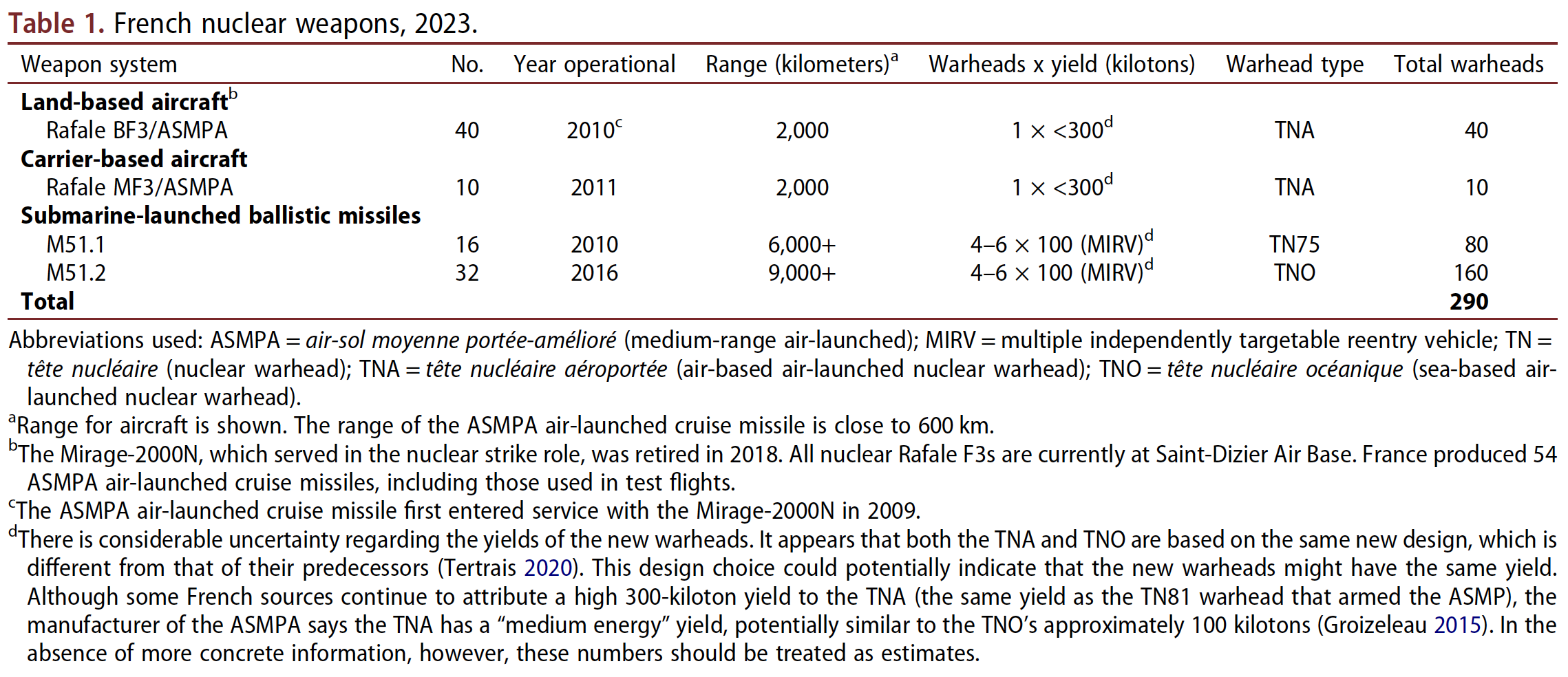
As Sarkozy said in 2008, the 300-warhead stockpile is “half the maximum number of warheads [France] had during the Cold War” (Sarkozy 2008). By our estimate, the French warhead inventory peaked in 1991–1992 at around 540 warheads, and the size of today’s stockpile is about the same as it was in 1984, although the composition is significantly different.
France’s nuclear doctrine
Successive heads of state, including Presidents Sarkozy, Hollande, and now Macron, have periodically described the role of French nuclear weapons. The Defense Ministry’s 2017 Defense and National Security Strategic Review reiterated that the nuclear doctrine is “strictly defensive,” and that using nuclear weapons “would only be conceivable in extreme circumstances of legitimate self-defense,” involving France’s vital interests. What exactly these “vital interests” are, however, remain unclear. In February 2020, President Emmanuel Macron announced that France’s “vital interests now have a European dimension,” and sought to engage the European Union on the “role played by France’s nuclear deterrence in [its] collective security” (Élysée 2020). Macron clarified in October 2022 that these vital interests “would not be at stake if there was a nuclear ballistic attack in Ukraine or in the region,” apparently attempting to avoid being seen as expanding French nuclear doctrine (France TV 2022). Explicitly ruling out a nuclear role in case of Russian nuclear escalation in Ukraine appeared to contradict France’s statement at the August 2022 Review Conference for the Treaty on the Non-Proliferation of Nuclear Weapons, which explained that “for deterrence to work, the circumstances under which nuclear weapons would [or would not] be used are not, and should not be, precisely defined, so as not to enable a potential aggressor to calculate the risk inherent in a potential attack” (2020 Review Conference of the Parties to the Treaty on the Non-Proliferation of Nuclear Weapons 2022).
France does not have a no-first-use policy and reserves the right to conduct a “final warning” limitednuclear strike to signal to an adversary that they have crossed a line—or to signal the French resolve to conduct further nuclear strikes if necessary—in an attempt to “reestablish deterrence” (Élysée 2020; Tertrais 2020). Although France is a member of NATO, its nuclear forces are not part of the Alliance’s integrated military command structure. The Defense Ministry’s 2013 White Paper says the French nuclear deterrent “ensures, permanently, our independence of decision-making and our freedom of action within the framework of our international responsibilities, including in the event of any threat of blackmail that might be directed against us in the event of a crisis” (French Ministry of Defense 2013). If an aggressor is not deterred, President Macron explained in 2020, France’s “nuclear forces are capable of inflicting absolutely unacceptable damages upon that State’s centers of power: its political, economic and military nerve centers” (Élysée 2020). For a more in-depth examination on the evolution of France’s nuclear doctrine, see Bruno Tertrais’ authoritative report, “French Nuclear Deterrence Policy, Forces and Doctrine” (Tertrais 2020).
During a hearing in the French Parliament on January 11, 2023, General Thierry Burkhard, the French Chief of Defense, further explained France’s nuclear doctrine: “[Our deterrent] is not articulated around the notion of threshold, because it would allow our adversaries to maneuver around in conscience and circumvent our deterrence ‘from the bottom up.’ Our deterrence capability guarantees second-strike possibilities through the redundancy of resources and the invulnerability of the sea-based leg. The possibility of using the nuclear weapon first is assumed: our doctrine is neither that of no first use nor that of the sole purpose, according to which nuclear weapons are only addressed to the nuclear threat … Nuclear deterrence does not seek to win a war or prevent losing one” (Burkhard 2023; our translation).
Concerning the implications of the Russia-Ukraine war for the role of nuclear weapons, Burkhard said: “The war in Ukraine confirms the strategic value of nuclear deterrence and its moderating effect in any conflict involving one or more nuclear powers. Everyone has also noted a great restraint on the part of the Russian forces vis-à-vis NATO … The other lesson to be learned from the Ukraine war is of course the return of the balance of terror by the threat of force, a customary action during the Cold War” (Burkhard 2023; our translation).
France typically conducts four air-based nuclear exercises each year, known as “Poker.” These exercises are intended to simulate a strategic air raid and are conducted in the skies above France (see Figure 1). The “Poker” exercise involves a majority of France’s nuclear-capable Rafale aircraft, which carry simulated air-sol moyenne portée-amélioré (ASMPA) air-launched cruise missiles (Air & Cosmos International 2022; Service de l’Information Aéronautique 2022). The most recent “Poker” exercise was conducted in March 2023, and included nuclear-capable Rafale aircraft from both the Forces Aériennes Stratégiques (FAS) and the Force Aéronavale Nucléaire (FANu) (Marine Nationale 2023).
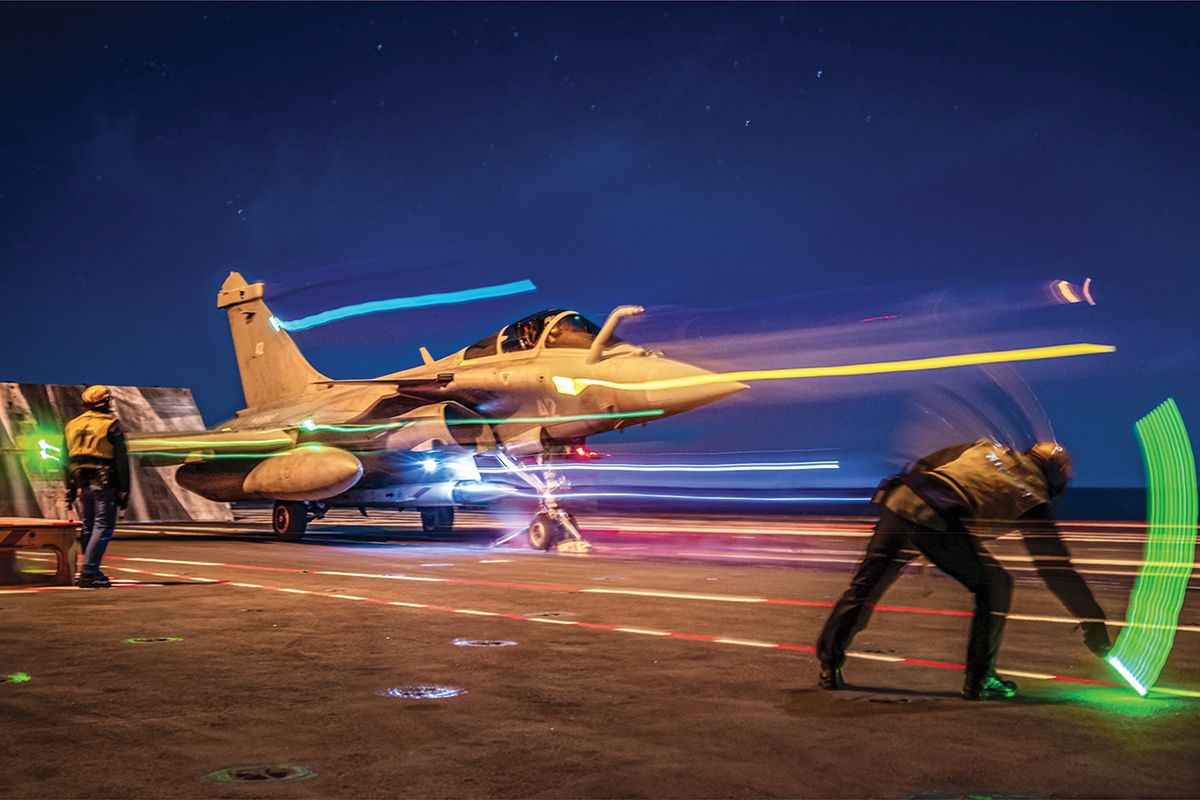
Under President Macron, France has engaged in a long-term modernization and strengthening of its nuclear forces. The 2018 Law on Military Planning (Loi de Programmation Militaire, or LPM) for 2019 through 2025 allocated €37 billion ($43.7 billion) for maintenance and modernization of France’s nuclear forces and infrastructure (Assemblée Nationale 2023). This was a significant nominal increase from the €19.7 billion ($21.8 billion) allocated by the LPM for 2015 through 2019 (Journal Officiel de la République Française 2013). The 2022 budget of the Ministry of the Armed Forces (France’s defense ministry) allocated €5.3 billion ($6.3 billion) to nuclear weapon-related activity, which was €0.3 billion more than in the 2021 budget (MAF 2022, 43; Rose 2020). This number increased again when France released its 2023 budget plans, allocating €5.6 billion ($6.14 billion) toward modernizing its nuclear forces (MAF 2023, 41).
Submarine-launched ballistic missiles
The French force of submarine-launched ballistic missiles (SLBMs) constitutes the backbone of the French nuclear deterrent. Under the command of the Strategic Ocean Force (Force Océanique Stratégique, or FOST), the French Navy (Marine Nationale) operates four Triomphant-class nuclear-powered ballistic missile submarines (SSBNs) equipped with nuclear-armed long-range ballistic missiles—Le Triomphant (hull number S616), Le Téméraire (S617), Le Vigilant (S618), and Le Terrible (S619).
Like the other Western nuclear powers, the French Navy maintains a continuous at-sea deterrent posture with at least one boat on patrol, one preparing for patrol, one returning to port, and one in maintenance. Each submarine patrol lasts an average of approximately 70 days, and FOST completed its 500th deterrent patrol in July 2018 when Le Téméraire returned to Île Longue, marking 46 years of continuous SSBN patrols since the first one in 1972 (French Ministry of Defense 2018b). In March 2022, the French Navy temporarily deployed more than one SSBN for the first time since the 1980s, likely in response to Russia’s invasion of Ukraine (Newdick 2022).
The SSBN force is based at the Île Longue naval base near Brest in Brittany, which includes two drydocks, nuclear warhead storage, and a unique facility with what appears to be 24 vertical silos for storing missiles that are not loaded on submarines. The missiles are assembled about four kilometers south of the base at the Guenvénez pyrotechnic site. Long-term submarine repairs and refueling take place at the Brest naval base across the bay, which has three large drydocks (Naval Technology n.d.). The SSBNs are built and dismantled at the shipyard in Cherbourg. (See Figure 2).
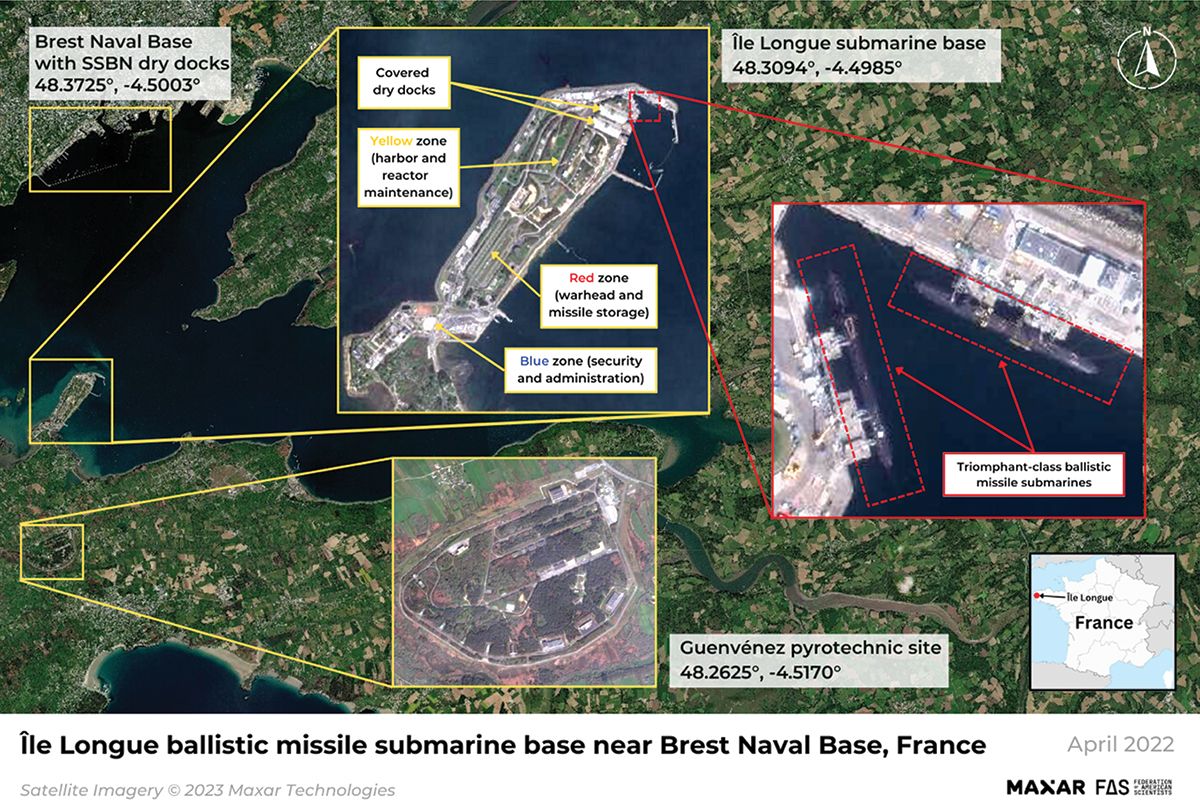
Over the past few years, several infrastructure upgrades have taken place at Île Longue that are visible through satellite imagery, including the construction of a new electrical plant and pumping station, as well as what appears to be a covered bunker enclosing a rail spur that connects to the SSBNs dry docks.
France relocated its SSBN command center from Houilles, Yvelines to the Île Longue base in 2000, while submarine communication facilities continue to operate using France’s HWU transmitter at Rosnay and possibly other locations. French SSBNs are protected during their operations by nuclear attack submarines, maritime patrol aircraft (such as Atlantique 2s), anti-submarine frigates, and minesweepers.
All French SSBNs now carry the M51 SLBM, which was deployed starting in 2010 to gradually replace the M45 SLBM (Tran 2018). The last M45 was withdrawn from service in September 2016 (Assemblée Nationale 2023). The M51 has reportedly been developed in close conjunction with the Ariane 5 space-launch vehicle, and the two share a number of technological commonalities, including solid-fueled heavy boosters, electronics, wiring, and guidance systems. The three-stage M51 reportedly has a range of over 6,000 kilometers and carries a liquid-propellant post-boost vehicle, allowing for the deployment of multiple independently targetable reentry vehicles (MIRVs) and penetration aids (Tertrais 2020; Willett 2018).
The M51 is undergoing continuous iteration: The first version—the M51.1—had improved range and accuracy over the M45 and could carry up to six 100- kiloton TN75 MIRV warheads. In December 2017, the French Defense Minister noted that the second version, known as M51.2, had become operational, although the newer missile was reportedly commissioned in 2016 (Assemblée Nationale 2023; Parly 2017). The M51.2, which the French Ministry of Defense says is “capable of far greater range” than the predecessor (possibly more than 9,000 kilometers), and carries a new warhead—the tête nucléaire océanique, or TNO. The TNO is reportedly stealthier than the TN75 and reportedly weighs about 230 kilograms, approximately double that of the TN75. It is unclear how many TNO warheads the M51.2 SLBM can carry, but it is suspected that some missiles have been downloaded to carry fewer warheads to increase targeting flexibility in limited scenarios (Tertrais 2020, 57). At least three of France’s four submarines had been upgraded to the M51.2 version carrying the TNO as of May 2023; French nuclear officials stated that the TN75 remained in service with the M51.1 missile as recently as January 2023 (Assemblée Nationale 2023). Based on these and other comments from French officials and the refit schedule of France’s four submarines, it is believed that one final submarine—Le Vigilant—has yet to be upgraded.
A third iteration of the missile—the M51.3—began development in 2014, is scheduled for commissioning onboard one of France’s SSBNs in 2025 and will incorporate a new third stage for extended range and further improvement in accuracy (Assemblée Nationale 2023; Parly 2017). The M51.3 will carry “an adapted oceanic warhead” and a future M51.4 is also planned (Salvetti 2023).
Each submarine can carry a set of sixteen M51 SLBMs, but since one boat is always undergoing routine maintenance, France has only produced 48 SLBMs—enough missiles to equip each of France’s three operational SSBNs.
France typically test-launches its SLBMs from two locations: on land at DGA Essais de Missiles near Biscarrosse, and at sea near the same site. The most recent test of the M51 SLBM, on April 19, 2023, was conducted from Le Terrible, which was the first SSBN to receive the M51 system in 2010. The test was likely related to upgrades from the M51.1 to the M51.2 SLBM, enabling it to carry the newer TNO warhead (Vavasseur 2023). This was the sixth test of the M51 from a submarine, and the eleventh test of the missile overall (MAF 2023).
Given that the Triomphant-class SSBNs are expected to reach the end of their operational lives in the 2030s, design work has begun on the new submarine class, the SNLE−3G (Assemblée Nationale 2023). Construction of the first class is expected to start in 2023 with plans for it to begin entering operational service around 2035. The SNLE−3G will incorporate a longer hull and advanced stealth features and will be equipped with the incoming M51.3 SLBM (Assemblée Nationale 2023; Mills 2020, 11; Vavasseur 2018). A fourth iteration of the M51—the M51.4—is also planned (Assemblée Nationale 2023).
Air-launched cruise missiles
The second leg of France’s nuclear arsenal consists of nuclear ASMPA (air-sol moyenne portée-amélioré) air-launched cruise missiles for delivery by fighter-bombers operated by the Strategic Air Forces and the Naval Nuclear Aviation Force. The bombers assigned to the nuclear mission also serve conventional missions.
The Strategic Air Forces (Forces Aériennes Stratégiques or FAS) operate approximately 40 nuclear-capable Rafale BF3 aircraft organized into two squadrons—the EC 1/4 “Gascogne” and EC 2/4 “La Fayette” at Saint-Dizier Air Base (Air Base 113) about 190 kilometers east of Paris (Pintat and Lorgeoux 2017). EC 2/4 operated nuclear-capable Mirage 2000Ns at Istres Air Base until June 21, 2018, when the aircraft was officially retired from the French Air Force. After the Mirage 2000N’s retirement, EC 2/4 moved from Istres to Saint-Dizier. Now both squadrons operate Rafale BF3 twin-seat strike fighters, leaving the Rafale the sole aircraft responsible for France’s nuclear strike mission (French Ministry of Defense 2018b; Jennings 2018). The FAS includes approximately 50 percent of all Rafale crews (Assemblée Nationale 2023).
The Naval Nuclear Aviation Force (Force Aéronavale Nucléaire or FANu) operates at least one squadron (11F and possibly 12F) of 10 MF3 aircraft for nuclear strike missions onboard France’s sole aircraft carrier, the Charles de Gaulle (Tertrais 2020, 58). The French carrier is the only surface ship in NATO equipped to carry nuclear weapons. The FANu and its ASMPA missiles are not permanently deployed onboard the carrier but can be rapidly deployed by the president in support of nuclear operations (Kristensen 2009; Pintat and Lorgeoux 2017). While the Charles de Gaulle’s home port is Toulon on the Mediterranean coast, the aircraft are based at the Landivisiau Naval Aviation Base in northern France. The nuclear ASMPA missiles earmarked for deployment on the carrier are thought to be co-located with ASMPAs belonging to the Strategic Air Forces at either Avord Air Base or Istres Air Base— or possibly at both.
The ASMPA, which has a range of up to 500 kilometers, first entered service in 2009 and has completely replaced the older ASMP. France produced a total of 54 ASMPAs, including those needed for flight testing. In 2016, France launched a mid-life refurbishment program designed to maintain the missile into the 2030s (Mills 2020, 10; Scott 2022). The life-extended version is known as “air-sol moyenne portée-amélioré rénové,” or ASMPA-R, and will be equipped with the same warhead as the ASMPA, the tête nucléaire aéroportée (TNA). The missile’s producer, MBDA, says the warhead has a “medium energy” yield, possibly similar to the yield of the TNO (Kristensen 2015; MBDA n.d.). The first firing of the ASMPA-R was conducted in December 2020, and after a successful qualification firing in March 2022, France approved the upgraded missile’s serial production and refurbishment (Assemblée Nationale 2023; Direction générale de l’armement 2022; Scott 2022). Operational commissioning of the renovated missile is scheduled for the end of 2023 (Assemblée Nationale 2023).
The French Ministry of the Armed Forces is also developing a successor to the ASMPA-R: a fourth-generation air-to-surface nuclear missile (air—sol nucléaire de 4e génération, ASN4G) with enhanced stealth and maneuverability that is scheduled to reach initial operational capability in 2035 and remain in service beyond the 2050s (Assemblée Nationale 2023). The missile will incorporate new hypersonic technologies to enable its maneuverability at high speeds (Assemblée Nationale 2023). France’s Rafale aircraft are also being modernized, and the 2023 defense budget included plans for the delivery of 13 new Rafale aircraft to its armed forces with plans for an “all Rafale” air fleet by 2035 (Élysée 2023; Jennings 2021; MAF 2022, 41). When the ASN4G missiles become operational, they will be carried by Rafale F5s—two standards higher than the current F3 version (Assemblée Nationale 2023). Ten to fifteen years later, the ASN4G will be integrated onto France’s Next Generation Fighter, which is expected to replace the Rafale (Assemblée Nationale 2023).
At the October 2022 Euronaval exhibition, the French Armament General Directorate (DGA) revealed the latest design of the new generation aircraft carrier (Porte-Avions Nouvelle Génération, or PA-NG), which is expected to begin sea trials by 2037 and replace the Charles de Gaulle by 2038 (Peruzzi 2022; Saballa 2022). After some setbacks, France and Germany have also proceeded with their joint development of a sixth-generation combat aircraft that could potentially be nuclear-capable (Airbus n.d.; Sprenger 2018; Vincent and Bezat 2022).
Until 2009, management and storage of France’s air-launched nuclear weapons was conducted by Dépôts-Ateliers de Munitions Spéciales (DAMS) located at Saint- Dizier, Istres, and Avord Air Bases. In 2009, these three bases were adapted for ASMPA storage and renamed to “K Buildings” (Tertrais 2020). Although nuclear-capable Rafales operated by the Strategic Air Forces are all located at Saint-Dizier, all three bases serve as dispersal and storage sites. Moreover, Avord, Istres, or both are thought to serve as storage sites for the ASMPAs assigned to the Charles de Gaulle for the Naval Nuclear Aviation Force strike mission. (See Figure 3).
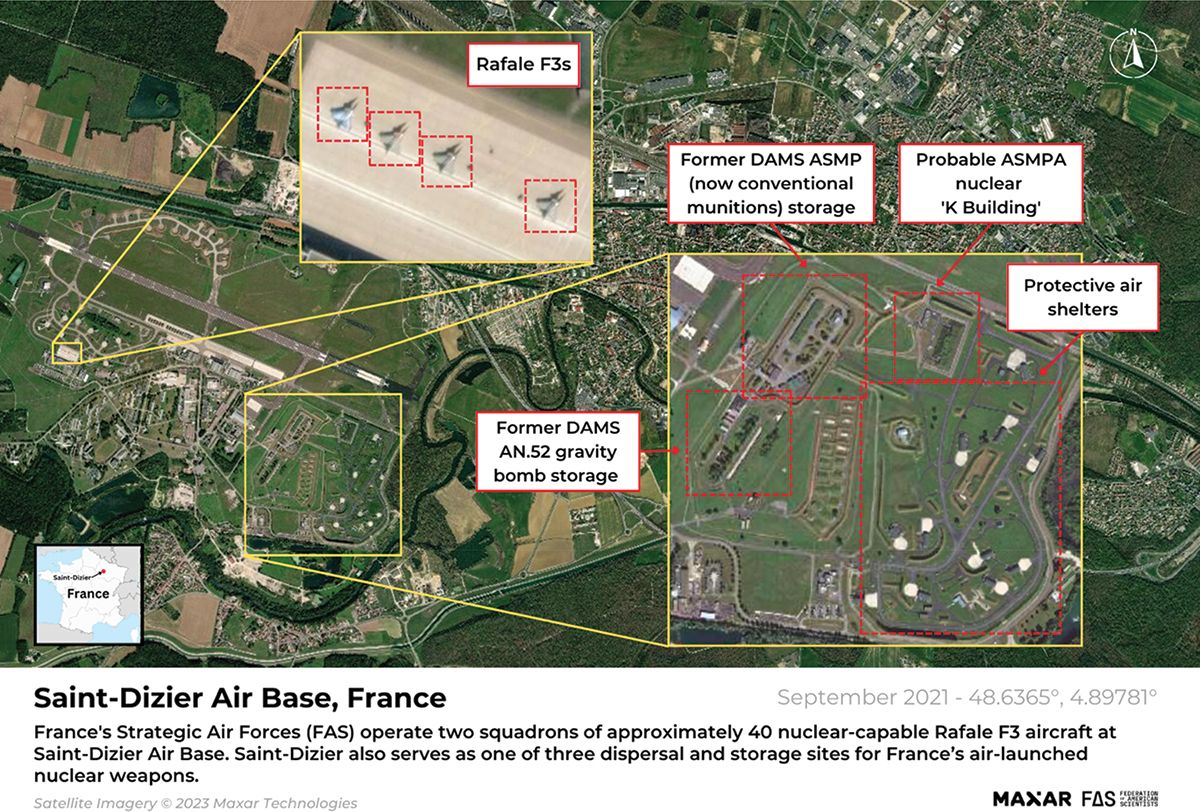
Given the Rafales’ relatively short range, France’s air-launched nuclear weapons capability depends on a support fleet of refueling aircraft. France currently operates a mixed fleet of Boeing C−135FR and KC−135 R tanker aircraft. Replacing this aging fleet has been a strategic priority for nearly a decade but was delayed significantly due to budget issues. The 2019–2025 LPM provided for an accelerated replacement of the older tankers to a fleet of 15 new Airbus A330–200 “Phénix” Multi-Role Tanker Transport (MRTT) aircraft (MAF n.d.). As of March 2023, the delivery of 9 Phénix aircraft had been completed, with three more scheduled to arrive by the end of 2023 (Airbus 2023; Assemblée Nationale 2023).
The nuclear weapons complex
France’s nuclear weapons complex is managed by the Direction des Applications Militaires (DAM), a department within the Nuclear Energy Commission (Commissariat à l’énergie atomique et aux énergies renouvelables, or CEA). DAM is responsible for research, design, manufacture, operational maintenance, and dismantlement of nuclear warheads.
Warhead design and simulation takes place at the DAM center in Bruyères-le-Châtel, about 30 kilometers south of Paris. The center houses the Tera 1000—Europe’s most powerful supercomputer with a 25 petaflop capacity—and employs about half the people affiliated with the military section of the Nuclear Energy Commission (CEA 2016).
The Commission’s Valduc Center, about 30 kilometers northwest of Dijon, is responsible for nuclear warhead production, maintenance, storage, and dismantlement. The site has recently expanded as a result of the 2010 French-British Teutates Treaty, an agreement to collaborate on technology associated with the two countries’ respective nuclear weapons stockpiles. The Epure facility at Valduc includes three high-power radiographic axes, including the AIRIX X-ray generator, which will “make it possible to characterize, to the highest level of precision, the state and hydrodynamic behavior of materials, under the conditions encountered in the pre-nuclear phase of weapon functioning,” as the Nuclear Energy Commission said in its 2017 annual report (CEA 2017, 4; Teutates n.d.). This function is critical to maintaining and developing France’s nuclear weapons in the absence of live nuclear test explosions. (See Figure 4).

Finally, the Nuclear Energy Commission’s CESTA (Centre d’Études Scientifiques et Techniques d’Aquitaine) near Le Barp is responsible for designing equipment for nuclear weapons and reentry vehicles, as well as for coordinating the development of nuclear warheads. The Megajoule laser, France’s equivalent to the US National Ignition Facility, is located at the same site. Construction on the Megajoule began in 2005 and it was first used to conduct experiments in 2014 (CEA 2016). It is designed to validate theoretical models of nuclear weapons detonations, and therefore plays an important role in France’s nuclear simulation program.
Research for this publication was carried out with generous contributions from the John D. and Catherine T. MacArthur Foundation, the New-Land Foundation, Ploughshares Fund, the Prospect Hill Foundation, Longview Philanthropy, the Stewart R. Mott Foundation, the Future of Life Institute, Open Philanthropy, and individual donors.
Together, we make the world safer.
The Bulletin elevates expert voices above the noise. But as an independent nonprofit organization, our operations depend on the support of readers like you. Help us continue to deliver quality journalism that holds leaders accountable. Your support of our work at any level is important. In return, we promise our coverage will be understandable, influential, vigilant, solution-oriented, and fair-minded. Together we can make a difference.










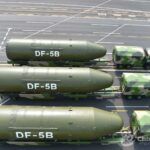
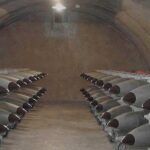
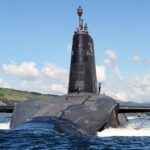
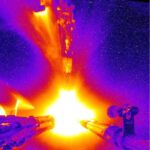

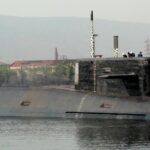








It probably makes sense that the countries that developed nuclear weapons before the NPT were WWII’s winners: the United States, the Soviet Union, the United Kingdom, France and China. As for Africa, it makes sense that the only country to do so was apartheid South Africa (thankfully, Nelson Mandela dismantled the nukes).
It has nothing to do with “making sense”. Countries have enacted massive programs to achieve this. Japan could have nuclear weapons. So could South Korea.